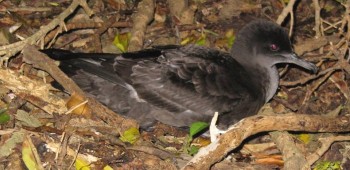The Kapiti Island Nature Reserve near Wellington, New Zealand is administered by the Department of Conservation and is open to tourist parties. It has been free of introduced mammalian predators for two decades (rats were eradicated in 1996). Among its prolific birdlife is a breeding population of Near Threatened Sooty Shearwaters Ardenna grisea near the island’s western cliff tops. The island’s shearwaters have been a risk to Wekas Gallirallus australis, an endemic (and flightless) New Zealand rail, that prey upon its eggs and young chicks.

Sooty Shearwater, photograph by West Coast Penguin Trust
Not being an introduced species to New Zealand (although introduced to Kapiti in the 1890s), and having a global status of Vulnerable with a decreasing population, their elimination from the island is assumed not to be an option, so a Weka-proof fence has been constructed to keep them out of the shearwater’s breeding site.
“Departure ramps were included in the construction to allow tītī [Sooty Shearwaters] to safely launch back out to sea from their breeding grounds. Motion sensor cameras will also tell us if any cunning weka have found any weak spots along the fence line. The next steps are to install some small one-way tunnels along the fence line, to give juvenile birds an extra exit route when they fledge. Night surveys of the colony in the New Year will hopefully prove more tītī chicks get that chance this breeding season”.
Read more here.
John Cooper, ACAP Information Officer, 19 January 2018

 English
English  Français
Français  Español
Español